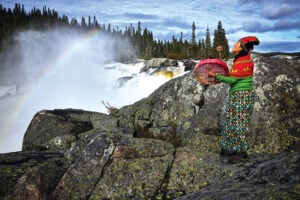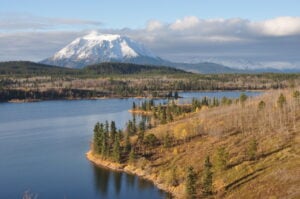But to find more evidence of the PETM, researchers left the oceans to learn more on land. There was something odd going on. Species obliterated. Increased acidity. Was there something we could learn to mitigate the damage of our own CO2- induced crisis? Perhaps paleoclimatologists would find more information perusing the geological library of land fossils.
In Wyoming’s Bighorn Basin, scientists found what they were looking for: a large red streak across the hills. It was a dusty red ribbon, seared into the mountains, that they hadn’t fully investigated — and it dated back to the PETM. But unlike the ocean cores, it was red for another reason. Harsh and volatile weather, mainly dry with intermittent heavy rains and storms, oxidized the soils and created the red hue. But to truly understand how the PETM affected life on Earth, scientists needed to find fossils: a glimpse of bygone life.
Three decades ago, one scientist decided to take up the challenge. As Scott Wing, curator of paleobotany at the Smithsonian National Museum of Natural History, tells me over Zoom from his home in Washington, D.C., wearing a pink Hawaiian shirt and with a fern plant in the background, he didn’t expect it would take him more than a decade.
Each summer for 12 years, his team scoured the barren hills of Wyoming’s Bighorn Basin, searching near the streak of red for signs of ancient life. In 2005, he had a eureka moment. While he was shovelling the dirt, several fossilized plants of exactly the right age emerged. “I started laughing, and then I started to cry because I was so happy,” he told a documentary filmmaker. By collecting a diversity of plant leaves, Wing and his team were able to plot their characteristics and determine the nature of the temperature changes 56 million years ago. The frequency of smaller leaves with smoother edges meant the climate was warmer and dryer.
A picture emerged from the burgeoning research: the Bighorn Basin was hot, dry and tropical, altered from the lusher epochs that bookended the period. And there was still a lot of life. Twisted bean trees grew up from the earth of the basin, with lizards and turtles inching by shoots of horsetails and cattails. Tiny horses (Sifrhippus) galloped by winding waterways, alongside a variety of other small hoofed mammals, like Meniscotherium and Diacodexis. Even early primates scampered through a scattered canopy. Farther north, in the Arctic, it was also hot but teeming with ancient crocodiles, and pre-primates with robust teeth that could survive in the Arctic winter darkness. The continents weren’t too different from where they are now, except India had yet to slam into Asia.
Critically, the research showed that temperatures became hotter and the oceans more acidic — and all this was caused by a major gush of CO2 into the oceans and atmosphere. But to really understand where we might be going, to see how climate change could affect us now, we need to understand how the PETM affected this tangled bank of life.













